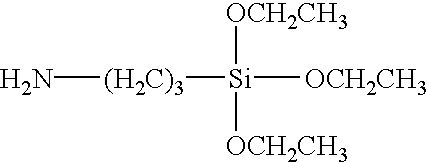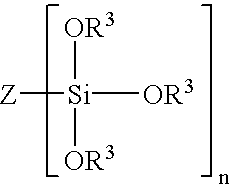Method of treating metals using amino silanes and multi-silyl-functional silanes in admixture
- Summary
- Abstract
- Description
- Claims
- Application Information
AI Technical Summary
Benefits of technology
Problems solved by technology
Method used
Image
Examples
example 2
Powder-coat Paint
Steel: A cleaner-coater was used that simultaneously cleaned and phosphated the metal surface. The panels were sprayed with Pyrene.RTM. 2-68 at 60.degree. C. for 3 minutes to produce an iron phosphate coating weight of 1.1 g / m.sup.2. This coating was given a post-rinse of Pyrene Eco Seal.RTM. 800 at 5 g / l.
Zinc (EZ & HDG): A cleaner-coater was used as above but one formulated for zinc and aluminium. The panels were sprayed with Pyrene.RTM. 2-69 at 60.degree. C. for 3 minutes to produce a coating weight on steel of 0.65 g / m.sup.2. The phosphate coating was post-rinsed with Pyrene Eco Seal.RTM. 800 at 5 g / l.
Aluminium: The same processing as for zinc above.
Table 2 shows the results of 1000 hour salt spray testing on powder coated steel, hot-dip galv and aluminium.
The silane mixture shown in Table 2 are as follows: (1) 2 vol % BTSE+1 vol % .gamma.-APS.
Table 3 shows the results of adhesion testing of powder coat films. The silane mixture shown in Table 3 are as follows: (...
example 3
Silane Pretreatment
The preparation of the silane solution (2% v / v BTSE+1% v / v .gamma.-APS and (2% v / v BTSE+0.5% v / v .gamma.-APS) was as follows:
3 parts by volume of BTSE was mixed with 4 parts by volume of demineralised water and 17 parts by volume of industrial methylated spirits. This mix was left for 7 days. The .gamma.-APS was hydrolyzed before use by adding 5% v / v water, mixing and leaving for 24 hours. This solution was then diluted with demineralised water to give 0.5 and 1% v / v .gamma.-APS and the pH adjusted to 6 with acetic acid. Enough hydrolyzed BTSE was then added to the neutralised .gamma.-APS to give 2% BTSE.
For the application to steel as a pretreatment it has been found that the pH of the silane solution can adversely affect some grades and / or surface finishes of steel by causing rusting. We have found that applications of solution at pH 6 have been consistently reliable for all the variants we have encountered so far. For ease of operation this pH has also been ado...
example 4
Coil-coat Applications on Three Substrates
.gamma.-APS / BTSE was treated on ACT CRS, Baycoat Hot Dipped Galvanized Steel (HDG) and Galvalume.RTM. panels. The control panels were B1000 P60 DIW for CRS, Chromate treatment on Baycoat production line for HDG and Galvalume. Galvalume panels were painted with primer (m856-016) and top coat (22-20752); HDG panels were painted with primer (PMY 0154) and top coat (SPG 0068), made by Lilly Industries; CRS panels were painted with 80G Newell White Polyester (408-1-w976), made by Specialty Coating Company. They are all polyester base paint.
Table 5 shows the corrosion test results (Salt Spray Test Results(mm) (Polyester Coil paint)) for the following compositions.
1. .gamma.-APS 0.5% vol.+BTSE 2% vol. pH=5
2. .gamma.-APS 1% vol.+BTSE 2% vol. pH=5
PUM
| Property | Measurement | Unit |
|---|---|---|
| Fraction | aaaaa | aaaaa |
| Fraction | aaaaa | aaaaa |
| Percent by mass | aaaaa | aaaaa |
Abstract
Description
Claims
Application Information
 Login to View More
Login to View More - Generate Ideas
- Intellectual Property
- Life Sciences
- Materials
- Tech Scout
- Unparalleled Data Quality
- Higher Quality Content
- 60% Fewer Hallucinations
Browse by: Latest US Patents, China's latest patents, Technical Efficacy Thesaurus, Application Domain, Technology Topic, Popular Technical Reports.
© 2025 PatSnap. All rights reserved.Legal|Privacy policy|Modern Slavery Act Transparency Statement|Sitemap|About US| Contact US: help@patsnap.com



